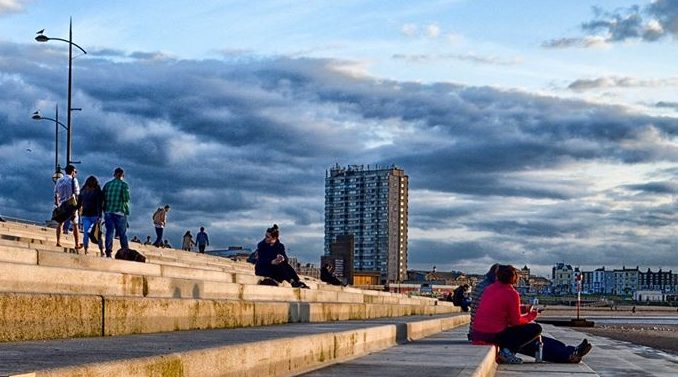
By Dan Thompson
In a town full of distinctive buildings, the one that stands tallest is Arlington House.
Post-Second World War, Margate was a town in decline. Before the war, the town had 30 first-class hotels, and nearly 3000 smaller hotels, guest houses and boarding houses. After the war, just two hotels and a handful of boarding houses survived. In 1953, a storm surge caused even more damage to Margate’s tourist infrastructure, damaging the Westonville Pavilion, Marine Terrace Bathing Pavilion, Lido, and Jetty. At Cliftonville, bathing pavilions and cafes were completely destroyed. It was obvious that the town needed to modernise.
In December 1960, property developer Bernard Sunley visited the Casino site, adjacent to the Dreamland Cinema on the seafront. His company provided what was then a unique service – a complete package of development for local councils, taking over sites, clearing them, and seeing the project through to completion. Sunley had made his money building airfields during the Second World War, but was now known for high-end developments in Manchester and London, including offices, shopping centres, and housing, and had subsidies working in Jamaica, the Bahamas, Canada, Australia, and South Africa. In Margate, they partnered with Northdown Road estate agent Robert Crittenden.
The site they chose had once been the location of Margate Sands railway station, which had closed in the 1920s. The council bought the site in 1926. The station buildings became the Casino Dance Hall and a cafe, but they were destroyed by fire in October 1946, just after the Second World War. The site was cleared and used for parking cars and coaches. Crittenden had first met with the Town Clerk, Borough Surveyor and the council’s Treasurer, before showing Bernard Sunley the site. After his visit, on a very rainy day, the plans were kept secret, before being announced at a press conference in March 1961.
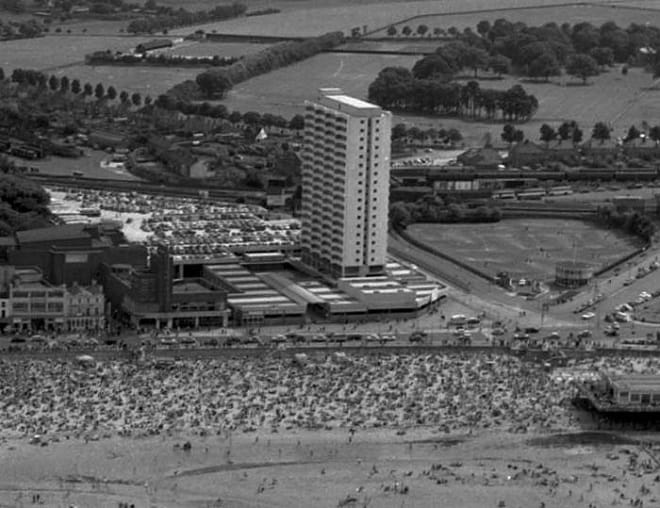
Sunley would build a tower block of luxurious flats with car parking, high-speed lifts and a 24 hour porter. The flats could be leased for 3, 5 or 7 years. Today, they remain as built – eight on each floor, four either side of a central corridor which has stairs at each end. Thanks to the zig-zag plan, every flat has views of both sea and countryside. The flats originally came with hot water, ‘Scandanavian electric heaters’, and kitchens with vinyl floor tiles and stainless steel sinks. Every flat had Rediffusion radio and television. There were aluminium sliding windows, which still remain, and give the block its bold horizontal stripes. The concrete included a crushed flint aggregate, to whiten the concrete and make it sparkle in the sunshine.
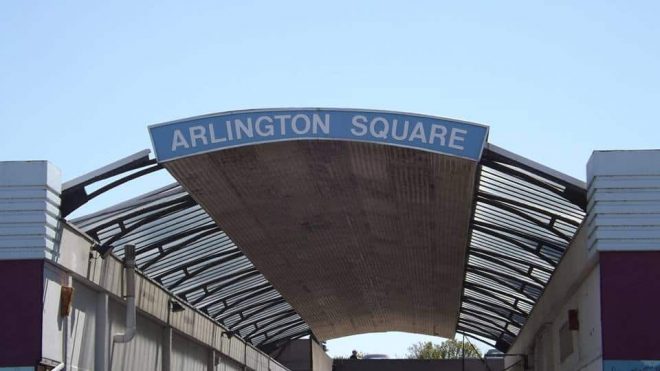
An adjacent shopping centre was created, around a new piazza – ‘the only modern shopping centre in Margate’. It had 50 shops, from small kiosks to a large, modern supermarket. There was parking for 500 vehicles, making it ‘Britain’s first park and buy shopping centre’. The whole development was going to be the first stage of Margate’s redevelopment, as the town would become a modern seaside resort, similar to the ones Sunley had built in the Bahamas and would later build in Spain. There were suggestions of a new theatre, swimming pool, and rooftop gardens to come, but no plans for these exist – although it is suggested the gardens were for the roofs of the shops facing All Saints Avenue, not the towerblock.
Arlington House was designed by architect Russell Diplock, who also designed the Brighton Centre and nearby Churchill Square, which included far more simple residential towers.
Arlington House was completed and opened in December 1963, less than three years after it was first announced. The Thanet Times described it as a ‘lovely brand new skyscraper’, and it was widely accepted as a popular building. But things didn’t go well.
In 1964, Margate hit the headlines for all the wrong reasons, when Mods and Rockers battled on the seafront. Seen from today, this subcultural scrapping seems quite minor, but at the time it was considered a real threat to the stability of society. Perhaps as a consequence, the flats in Arlington House didn’t sell, and many of Arlington Square’s shops stayed empty.
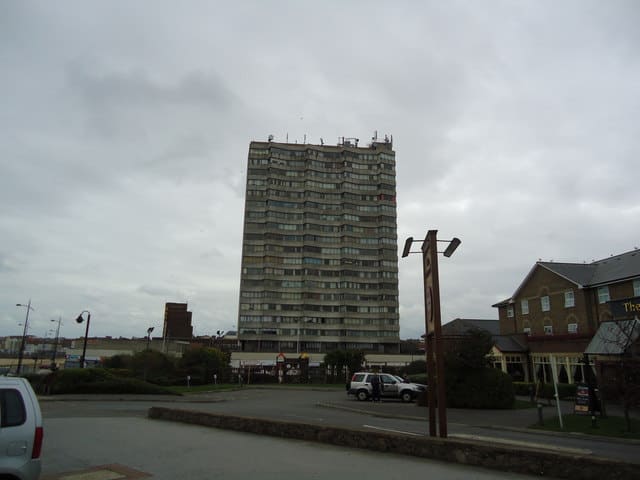
In July 1964, the Sunday Mirror reported ‘Hermit is living in this block of luxury flats’. Only 73 year old ex-army captain George Cook and his wife were living in the block, on the 10th floor. Rents had been reduced, and new tenants were given a rent-free period. The Bernard Sunley Group said ‘The block is a bit ahead of its time’.
By 1969, Arlington Square had a Mace supermarket, Green Shield Stamp shop, and was home to local names like Regal Gifts and menswear store Prince Regent, when the whole site changed hands. Freshwater Group, who specialised in taking over struggling shop centres, were the new owners. They also had 15,000 homes on their books, in seaside towns like Eastbourne, Hastings and Worthing. They redesigned the original Arlington Square, and seven years late, Arlington Square was declared open in August 1970. TV star Wendy Craig cut the ribbon, The Kingpins played country and western, and at Slimerama beauty salon, dads were invited to guess the weight of the ‘bikini beauty’ in the window.
Many flats stayed unoccupied, and the building struggled with a poor reputation. In 1979, Hawkwind’s song High Rise was apparently inspired by the building, as it was written by Bob Calvert who lived in the block.
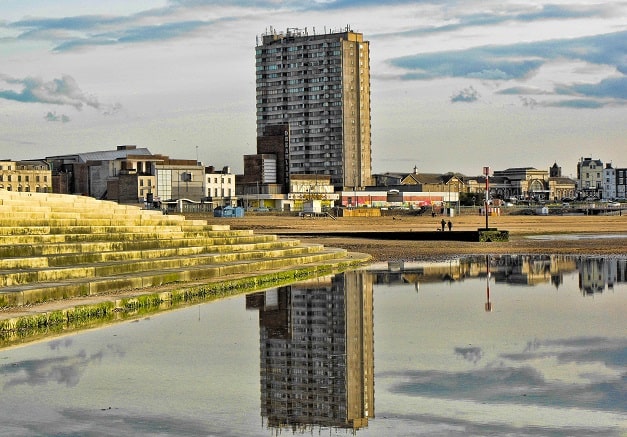
In 2001, one man died after a fire on the 16th floor of the building, and as a consequence, gas was removed from the building.
Arlington had a relatively stable existence until 2011, when plans to demolish the carpark and shopping centre to build a large seafront Tesco store were announced. Freshwater said the plans had been ten years in the making. A huge campaign in opposition to the plans, which focused on the impact of a huge shed on the seafront views and on neighbouring Dreamland, was started.
In the end, the delays meant that Tesco’s needs had changed, and in 2014 they quietly dropped their plans. In the meantime, though, Freshwater had closed the shopping centre, and all the shops remain boarded up to this day.
Dreamland’s reopening in 2015 focused attention on the Arlington site, and by 2018, Dreamland chief executive Aidan de Brunner had confirmed the amusement park were interested in the site, as well ‘Godden’s Gap’ on the other side of the park’s seafront entrance. In any new development, he said, ‘you can’t get away from the overbearing presence of Arlington House’.
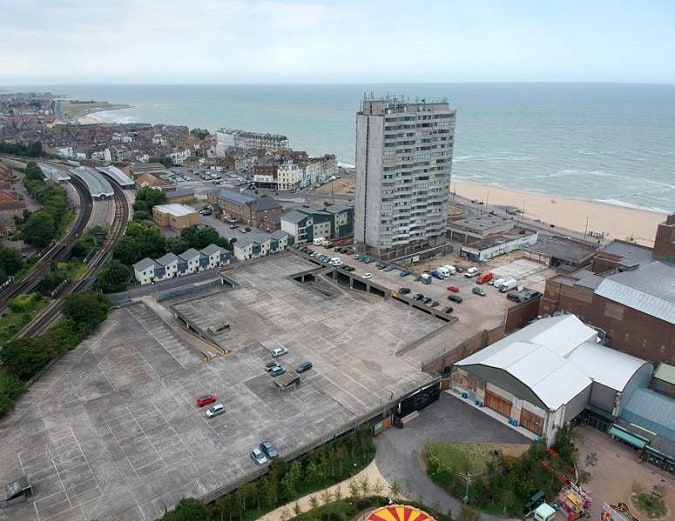
The block featured in a number of music videos, by bands including Dead 60s, Foxes, and Kormac ft, Irvine Welsh. And it was the backdrop for fashion shoots by labels like Dr Martens and Pretty Green.
All of this helped people to see the building differently and, as Brutalist architecture was having a fashionable revival, the flats started to fill,. By 2020 Arlington House had the highest occupancy since it was opened.
As the 20th Century Society, dedicated to the preservation of the century’s best architecture, made Arlington House the cover star of their magazine at the start of 2020, it seemed as if the Sunley Group’s prediction was right: Arlington House may have been ahead of its time, but the world had caught up with it.

